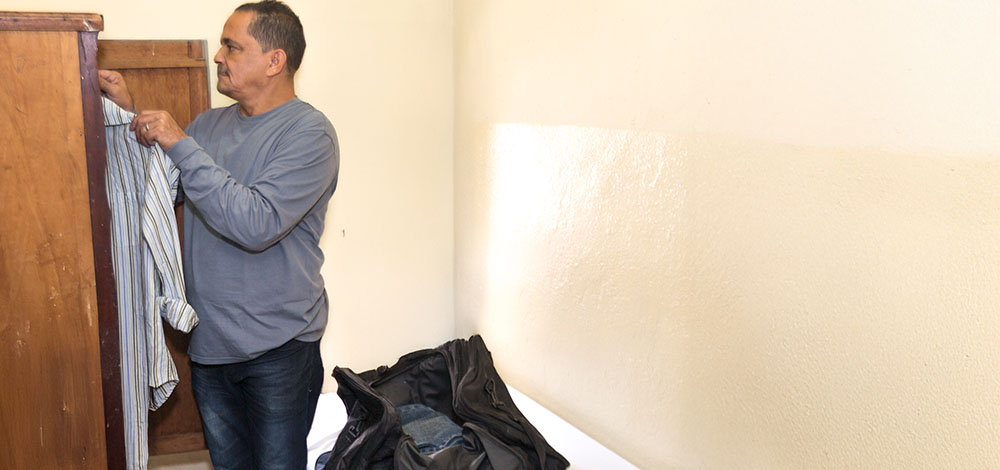|
Getting your Trinity Audio player ready…
|

The independent evaluation of Project Roomkey is out, and the verdict is in. It worked.
As has been widely reported in the media, California’s Project Roomkey successfully provided emergency housing to 62,000 people experiencing homelessness after COVID-19 took hold. The initiative was developed to protect the health of program participants by reducing their exposure to the coronavirus and to minimize the anticipated strain on the health care system by limiting its spread.
It was nothing short of revolutionary that as the pandemic shut down the world, multiple state and county government agencies in California worked with the homeless response system and health care partners to rapidly put this program in place. Participants were offered clean, private rooms in hotels and motels instead of a cot in a crowded shelter, and this gave them a sense of autonomy and safety. The clients stayed, and they largely liked their living quarters, debunking the cruel myth that people live on the street because they want to.
There are three other key takeaways from Project Roomkey that signal a new path forward in providing effective housing and care for people experiencing homelessness.
1. Health Care Services Must Be Provided On-Site
Project Roomkey focused on people at high risk for hospitalization or death from COVID-19 — those who were over 65 and those with chronic health conditions. Almost immediately, Project Roomkey staff came to see how medically complex the Roomkey clients were. The staff knew they needed partnerships with health care providers who could deliver care on-site. Across the state, all sites offered varying levels of care, including physical health care, behavioral health care, assistance with activities of daily living, and housing navigation. Before Project Roomkey, this kind of collaboration did not exist at scale. Through the pandemic crisis, new partnerships were formed between health care providers and homeless service providers for the betterment of patients. An article in The CHCF Blog profiled a United Way–funded program in Los Angeles that brought health care services into Project Roomkey sites.
“When you consider this project in the context of other integrated care and street medicine efforts, it certainly adds to the overwhelming evidence that this site-based approach works, bringing care to where people are,” said Joelle Greene, PhD, director at Harder+Company Community Research, who led an evaluation (PDF) of the United Way program. “It’s going to take those kinds of integrated efforts to really get the outcomes we want for people, which is not only being stably housed but having a quality of life that they would want.”
Project Roomkey proved these cross-sector collaborations are scalable.
2. Data Sharing Agreements Are Urgently Needed
Project Roomkey was intended to move people into safe housing for public health reasons and to keep them out of the hospital, prevent death, and in some settings improve their health. Unfortunately, data to evaluate Roomkey participants’ housing and health outcomes in tandem were not available. California’s health care, social services, and housing data systems are siloed and at this point cannot interact. In state government, housing data are kept in the Homeless Data Integration System (HDIS), while health data are maintained by either the Medi-Cal system or the Department of Health Care Access and Information. In our communities, data are similarly compartmentalized across local Homeless Management Information Systems, electronic health records, managed care plan platforms, and other social services and closed-loop referral systems.
To understand and scale what’s working, we need these systems to communicate with each other. The state has moved mountains to launch the Data Exchange Framework, but that is focused on health care entities. Right now, there is no mandate for HDIS to share housing data with health and social services providers. In the Project Roomkey evaluation, the authors recommend that such data sharing agreements be created at the state level.
Some counties already do that. Humboldt County, for example, has a health information exchange in place. Since it was launched in 2016, psychiatric hospitalizations among clients who are unhoused, staying in shelters, or living in permanent supportive housing are down 60%. San Diego, Alameda, and Los Angeles Counties are also working hard on this issue.
3. CalAIM Offers Significant Opportunities
Through its groundbreaking CalAIM (California Advancing and Innovating Medi-Cal) initiative, Medi-Cal for the first time offers a payment mechanism for supports that are desperately needed by people experiencing homelessness — especially people with complex medical issues. Too often, people discharged from hospitals have nowhere to go except back to the street. Through the Community Supports program, people can be discharged to medical respite care, so they can stabilize medically before transitioning to posthospitalization housing (PDF) for up to six months. During a stay in these interim housing options, people can obtain housing navigation services to line up permanent housing.
These Community Supports are not as widely offered and authorized as they should be. The evaluation team recommends that managed care plans provide guidance and training to make it easier for homeless service providers and system leaders to access Community Supports for their clients. The team also recommends that managed care plans invest in their local homeless response systems through incentive programs, community benefits, or flexible contracting with the community-based organizations that are best suited to provide these services.
One last finding in the Project Roomkey evaluation is crucial. The longer people stayed in a Roomkey site, the more likely they were to transition to permanent housing. Project Roomkey proves the concept that if people are given housing where they have privacy and autonomy with the services they need, health and housing stability can follow.
Authors & Contributors


Harrison Hill
Harrison Hill is a documentary photographer and filmmaker based in Los Angeles, California. His work focuses on social justice issues centered around communities of color in the US.




